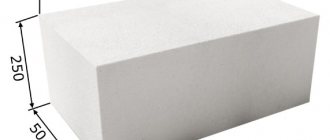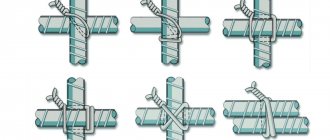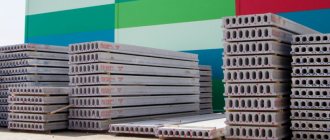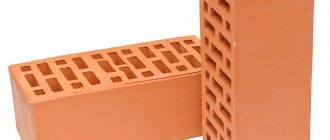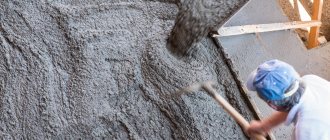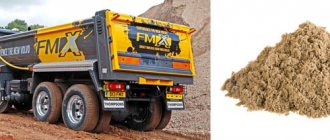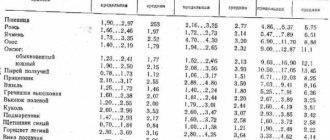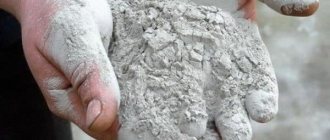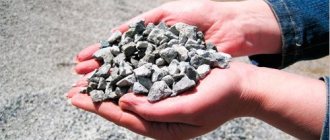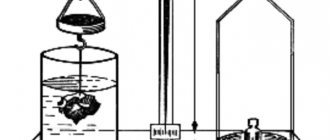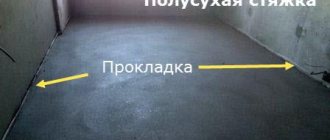The dependence of the mass of reinforcement on the density of steel is obvious, but to simplify the calculations, there are also correspondence tables. So that you don’t have any difficulties when calculating this expensive material, let’s figure out how much it needs to be used during construction. When constructing monolithic reinforced concrete structures, steel reinforcement is used, the weight of which may vary per linear meter due to the unequal thickness of the metal rods. Let's look at how to control their consumption step by step.
How to find out the volume of reinforcement?
In drawings and diagrams of steel frames and meshes, designers indicate the weight and length of each assembly element and ultimately summarize the costs of materials in calculations.
These design values are relied upon both when drawing up estimate documentation, and when contractors purchase reinforcement, the weight of a linear meter does not change due to humidity, corrosion or other technical conditions. All these errors are already taken into account to the maximum in the table values. For example, according to the table, the weight of a linear meter of 10 mm reinforcement is 0.617 kg, but small inaccuracies are possible - per ton, according to the standards, they should be no more than ±5-6%. But these figures assume a confluence of the most unfavorable circumstances, so they try not to allow deviations of more than ±2-3% and prevent possible speculation. Hot rolled reinforcement. Weight of a linear meter of material.
| Section size of rods | Weight 1 linear m. | Reinforcement length in ton | Boundary weight deviations |
| Ø6 | 0.222 kg | 4504.5 m | ±7-9 % |
| Ø8 | 0.395 kg | 2531.65 m | ±7-9 % |
| Ø10 | 0.617 kg | 1620.75 m | ±5-6 % |
| Ø12 | 0.888 kg | 1126.13 m | ±5-6 % |
| Ø14 | 1.21 kg | 826.45 m | ±5-6 % |
| Ø16 | 1.58 kg | 632.91 m | ±3-5 % |
| Ø18 | 2 kg | 500 m | ±3-5 % |
| Ø20 | 2.47 kg | 404.86 m | ±3-5 % |
| Ø22 | 2.98 kg | 335.57 m | ±3-5 % |
| Ø25 | 3.85 kg | 259.74 m | ±3-5 % |
| Ø28 | 4.83 kg | 207.04 m | ±3-5 % |
| Ø32 | 6.31 kg | 158.48 m | ±3-4 % |
| Ø36 | 7.99 kg | 125.16 m | ±3-4 % |
| Ø40 | 9.87 kg | 101.32 m | ±3-4 % |
How many meters are there in a ton of reinforcement 12?
In accordance with building regulations, the amount of reinforcement in a strip foundation as a percentage of the reinforced concrete element in the cross-section must be at least 0.1%. In an example it looks like this. If the cross-sectional area of the strip foundation is 100*240=2400 square cm, then the estimated number of rolled rods for longitudinal reinforcement is found by multiplying the resulting volume of the foundation by 0.001, that is, 2400*0.001=2.4 square cm.
Next, you should resort to the reference data in the table from the manual on the reinforcement of reinforced concrete elements of monolithic buildings. Since we are interested in reinforcement with a diameter of 12, it is obvious that only 2 reinforced rods are needed for the calculated volume of the foundation. The calculation of the consumption of reinforced steel for a slab foundation is similar.
Calculation of the amount of reinforcement in fact
You can easily calculate the weight of the reinforcement based only on the length and diameter of the rods, since the density of steel is well known and is 7850 kg/m3. For example, the following condition: the reinforcement is 12, the weight of a linear meter is unknown, but its length in all frames is 100 m. We calculate the area of a circle with a radius of 6 mm, multiply by the height (that is, the length of the rods) and by the density of the material from which they are made. When calculating, we neglect the ribbing of the reinforcement. As a result we get: πR2×100×ρSTEEL=3.14×0.0062×100×7850=88.74 kg. After checking the table, we will make sure that the calculation is correct. At 100 meters of material, the deviation was only 0.06 kg, which easily fits into the maximum measurement error of ±3%.
Characteristics of A12 fittings
During the manufacturing process of A12, GOST 5781–82 is strictly observed, and according to its purpose it is classified into prestressed and non-prestressed . Based on the choice of production technology, the following types of fittings 12 are distinguished:
- cold drawn;
- hot rolled
Cold-drawn reinforcement A12 is necessary for the production of reinforced mesh; it is supplied in coils (rolls) of 6-12 meters and is a reinforcing wire.
Hot-rolled A12, being a high-quality type of rolled metal, is produced from steel with a rounded cross-section, and is used in the reinforcement of stressed and ordinary structures, imparts sufficient strength to reinforced concrete structures and prevents damage due to mechanical deformations.
Control of material consumption on a construction site
In any business, including such as the sale of rolled metal, everyone knows each other very well; accordingly, it is better to ask the foreman who will supervise the work on the construction site about the integrity of the sellers in your city. This specialist knows thoroughly where and why steel reinforcement is used; the weight of a linear meter of this structural material will also not be news to him. Therefore, do not forget to remind him to collect all receipts and invoices for rolled metal. After all, armed with drawings that indicate the length of the reinforcement of each welded mesh and frame, you can jointly take a fascinating tour of the building under construction and make sure that something has not rolled in the process, or just make sure that the materials are used optimally. The result of such mutually beneficial cooperation will be a perfectly executed building and your mutual satisfaction.
Distinctive features of A12 fittings
These rolled metal products can be made from steel of different grades, which depends on its application and the requirements for its characteristics. Most often, products made from low-alloy structural steel are required. This is due to the fact that such products are easily subjected to arc welding.
The main purpose of A12 is the strengthening of reinforced concrete structures , as well as the formation of frame devices to resist increased loads. A diameter of 12 mm is the minimum for the construction of a strip foundation and its grillages, if you knit a reinforcement frame of four rods. Rentals by class are:
- smooth profile (without corrugation) - class A1;
- periodic profile (with transverse corrugation at an angle to the axis of the rod) - class A3.
This construction metal product is presented from the manufacturer in rods or coils . The scope of its application is very wide. For the construction of the foundation, it is recommended to use hot-rolled reinforcement in the form of rods with oblique corrugation, the presence of which ensures optimal adhesion to concrete. This interaction of materials ensures the strength and durability of a reinforced concrete building structure. The transverse arrangement of reinforced rods in the foundation prevents concrete cracking and reduces the force load on the resulting structure, and also protects it from deformation.
Advantages of A12 reinforcement , which are manifested in construction:
- high degree of strength;
- relatively high ductility;
- minimal susceptibility to corrosion;
- high resistance to thermal, chemical and mechanical influences;
- the ability to create various structural configurations by welding and mechanical connections;
- Possibility of use in stressed structures made of reinforced concrete.
There is currently a fairly large selection of grade steel on the construction raw materials market. Recently, there has been a gradual transition, using the example of Europe, to products made from A500C steel instead of the previously popular A400. This fact, quite logically, is explained by the fact that while fully maintaining the quality characteristics of rolled products, its production cost is reduced by up to 10% due to savings in raw materials during construction operations. For construction calculations, this amount of expenses is simply colossal.
A special feature of the production of rolled products from this steel grade is the absence of oxidation and, as a consequence, the absence of rust. At the same time, mechanical, chemical and thermal qualities remain at a very high level. Replacement of steel grade A400 by grade A500C in rolled products makes it possible to reduce its concentration during concreting and, as a consequence, the consumption of A12 reinforcement. The technical characteristics of the steel used do not allow the welds of the finished structure to collapse. All this leads to increased strength of floors, columns and walls of buildings.
Read on to find out more!
Concrete: properties, types and applications
Two of the best concrete mix recipes
Vertical concrete placement technique
Protective layer of concrete for reinforcement
Concrete grade for strip foundation
Cement in bags M500
- 2.42
Rating: 2.4 out of 5 Votes: 185
- 4
Reply
5 years ago
5 years ago
deleted 5 years ago
Igor
5 years ago
Quote
For the manufacture of reinforcement frames for monolithic reinforced concrete structures, we always use smooth reinforcing steel, class A240, and periodic profile A400 and A500. When purchasing reinforcement, we always take a certificate for this product from the trading organization, which indicates all the characteristics of the reinforcing steel and its compliance with GOST. In frames, reinforcing steel is connected by electric welding or binding wire, depending on how specified in the project.
Egor
5 years ago
Quote
For pouring into concrete, there is no need to take reinforcement with increased corrosion resistance; concrete itself acts as a reliable means of protecting the reinforcement. Sometimes it is generally better to use metal shavings as a reinforcing component or polypropylene fiber.
Hope
5 years ago
Quote
If you know exactly for what purposes you are going to use the fittings, and also knowing some of its characteristics, it will be easier for you to make a choice when purchasing. According to the characteristics, A400 reinforcement is suitable for building cottages, strengthening road surfaces, and reinforcing floors or walls. It is divided into several categories. Additional indices indicate a certain type of reinforcement: “K” - anti-corrosion, “C” - weldable, “T” - heat-strengthened. Pay attention to the pattern of the reinforcement rib. Reinforcement with a ring pattern is better suited for more massive concrete structures. And with a crescent pattern, it is excellent for thin-walled construction.
Classification
According to GOST, the following range of construction reinforcement is produced from hot-rolled steel:
- a smooth, round metal rod;
- round corrugated rod.
The products are represented by a wide range: products made from different grades of steel, various sizes and diameters.
The entire range of construction reinforcement is divided into several classes presented in the table below: A1 (A240), A2 (A300), A3 (A400), A4 (A600), A5 (A800), A6 (A1000). The number following the letter “A” in the marking indicates the yield strength of the product. The range of smooth fittings has class A1, corrugated – from A2 to A6.
| Class | Reinforcement diameter | steel grade |
| A1 (A240) | from 6 mm to 40 mm | 3SP, D16, St3 (StZkp; StZps; StZsp) |
| A2 (A300) | from 10 mm to 80 mm | St5sp and St5ps - diameter from 10 mm to 40 mm; 18G2S - diameter from 40 mm to 80 mm |
| A3 (A400) | from 6 mm to 40 mm | St3, 25G2S, 35GS |
| A4 (A600) | from 10 mm to 32 mm | 80C - diameter from 10 mm to 18 mm; 20ХГ2Ц – diameter from 10 mm to 32 mm |
| A5 (A800) | from 6 mm to 36 mm | 23Х2Г2Т (AT800) |
| A6 (A1000) | from 6 mm to 32 mm | 22Kh2G2AYu, 22Kh2G2R, 20Kh2G2SR |
To improve adhesion to concrete, ribs are applied to the reinforcement during rolling. In addition to the index, product markings may contain letters characterizing the quality of the steel:
- “T” - with thermal hardening;
- “B” - reinforced by hood;
- “C” - suitable for welding;
- “K” - resistant to corrosive formations.
Reinforcement is divided into groups not only according to steel class, strength and surface type, but also:
- by functionality (unstressed and strained);
- by manufacturing technology (rope, wire and rod);
- by purpose (working, installation, distribution);
- by installation method (welded, knitted).
Reinforcement range – table
When calculating the permissible tensile load on a reinforced concrete structure, the diameter of the reinforcing rods is taken into account. In accordance with GOST 5781-81, there are 20 main diameters of reinforcement (the table below shows the weight in accordance with the diameter).
| Diameter of fittings, mm | Cross-sectional area, cm2 | Reinforcement weight, kg/m |
| 3 | 0,071 | 0,055 |
| 4 | 0,126 | 0,098 |
| 5 | 0,196 | 0,154 |
| 6 | 0,283 | 0,222 |
| 7 | 0,385 | 0,302 |
| 8 | 0,503 | 0,395 |
| 9 | 0,636 | 0,499 |
| 10 | 0,785 | 0,617 |
| 12 | 1,131 | 0,888 |
| 14 | 1,539 | 1,208 |
| 16 | 2,011 | 1,578 |
| 18 | 2,545 | 1,998 |
| 20 | 3,142 | 2,466 |
| 22 | 3,801 | 2,984 |
| 25 | 4,909 | 3,853 |
| 28 | 6,158 | 4,834 |
| 32 | 8,042 | 6,313 |
| 36 | 10,18 | 7,99 |
| 40 | 12,56 | 9,87 |
Wire reinforcement is available in four standard sizes: 3, 4, 5, 6 mm in cross section. Can be supplied in rod form or in skeins. Products of classes 1-4 are widely used in construction. For critical structures (tunnels, mines, bridges) higher grades are used.
Working reinforcement for the foundation must be at least 10 mm thick, and the maximum size is not limited. For the installation of columns, the minimum thickness of rolled products is 14 mm, the maximum is 36 mm. Panels and beams are reinforced with rods with a diameter of 12 to 32 mm.
The table shows the range of A500C reinforcement for reinforcing reinforced concrete structures.
| Reinforcement diameter, mm | Sectional area, mm2 | Weight of 1 meter, kg |
| 6 | 28,3 | 0,222 |
| 8 | 50,3 | 0,395 |
| 10 | 78,3 | 0,617 |
| 12 | 113 | 0,888 |
| 14 | 154 | 1,210 |
| 16 | 201 | 1,580 |
| 18 | 254 | 2,000 |
| 20 | 314 | 2,470 |
| 22 | 380 | 2,980 |
| 25 | 491 | 3,850 |
| 28 | 616 | 4,830 |
| 32 | 804 | 6,310 |
| 36 | 1018 | 7,990 |
| 40 | 1257 | 9,870 |
Hot-rolled steel for reinforcing reinforced concrete structures - A1 reinforcement is produced in the form of rods and coils and must comply with GOST 5781-82. The geometry of rolled products and maximum deviations of the diameter of smooth profiles must comply with GOST 2590-2006.
In the international classification, A1 fittings are designated class A240. This type of rolled product has a smooth profile. The main purpose of the A240 reinforcement is the production of loop elements in the production of reinforced concrete products and reinforced concrete structures. “Hinge elements” are primarily intended for fastening large reinforced concrete products to lifting mechanisms for transportation and installation on a construction site.
Other methods of using loop reinforcement are possible - a smooth rod connecting (connecting) the main package, made, for example, from A500C reinforcement. Where the main package performs the function of reinforcing reinforced concrete products, and smooth reinforcement connects the bars in the package. Similar functions are performed by wire rod, OH wire or A500C fittings of small sizes. The use of one or another type of product is determined by the designer.
Also, A240 reinforcement often serves as a blank for the production of cold-deformed periodic profile reinforcement of type B500, which in turn is also used for reinforcing small-sized reinforced concrete products. B500C reinforcement is often used in the manufacture of permanent formwork - a new production technology for waste-free construction.
in riots
| Size | Options | Brand | Meter weight, kg | Meters per ton |
| Reinforcement A1 f6 | riots | 3sp/ps | 0,222 | 4504 |
| Fittings A1 f8 | riots | 3sp/ps | 0,395 | 2531 |
| Fittings A1 f10 | riots | 3sp/ps | 0,617 | 1620 |
| Fittings A1 f12 | riots | 3sp/ps | 0,888 | 1126 |
in rods
| Size | Options | Brand | Meter weight, kg | Meters per ton |
| Reinforcement A1 f6 | 6; 9 | 3sp/ps | 0,222 | 4504 |
| Fittings A1 f8 | 6; 9; 11,7 | 3sp/ps | 0,395 | 2531 |
| Fittings A1 f10 | 9; 11,7 | 3sp/ps | 0,617 | 1620 |
| Fittings A1 f12 | 11,7 | 3sp/ps | 0,888 | 1126 |
| Fittings A1 f14 | 11,7 | 3sp/ps | 1,21 | 826 |
| Fittings A1 f16 | 11,7 | 3sp/ps | 1,58 | 633 |
| Fittings A1 f18 | 11,7 | 3sp/ps | 2 | 500 |
| Fittings A1 f20 | 11,7 | 3sp/ps | 2,47 | 404 |
| Fittings A1 f22 | 11,7 | 3sp/ps | 2,98 | 335 |
| Fittings A1 f25 | 11,7 | 3sp/ps | 3,85 | 259 |
| Fittings A1 f28 | 11,7 | 3sp/ps | 4,83 | 207 |
| Fittings A1 f32 | 11,7 | 3sp/ps | 6,31 | 158 |
| Fittings A1 f36 | 11,7 | 3sp/ps | 7,99 | 125 |
Specifications and useful information
Please note that the coefficients given in the table are reference values calculated theoretically. The actual weight of a meter depends on the precision and settings of the rolling mill. In accordance with the maximum deviations allowed by GOST and TU, the actual weight, depending on the size of the profile, may differ from the theoretical weight by 3-9%, both plus and minus.
A type of rod with a smooth surface without corrugation. Class A1 reinforcement is most often used as a reinforcing element for reinforced concrete products and pile foundations with and without tension. The main controlling standard is for AI steel, which can be used with prestressing for the purpose of reinforcing reinforced concrete structures.
Yield strength - 240 kgf/mm2, smooth profile, similar in appearance to wire or rod (depending on diameter).
The material for production is carbon steel of the St2ps, St3sp and other grades, as well as low-alloy steels with chromium additives.
The length of the A1 reinforcement varies from 6 to 12 meters. Thin rods can be used not only in foundations, but also for reinforcing fences, curbs and small metal structures. In addition, smooth profiles are often used in the manufacture of decorative elements, lamps, fencing structures and stairs. During the construction of residential buildings, lining and strengthening of walls and columns is done using this class.
